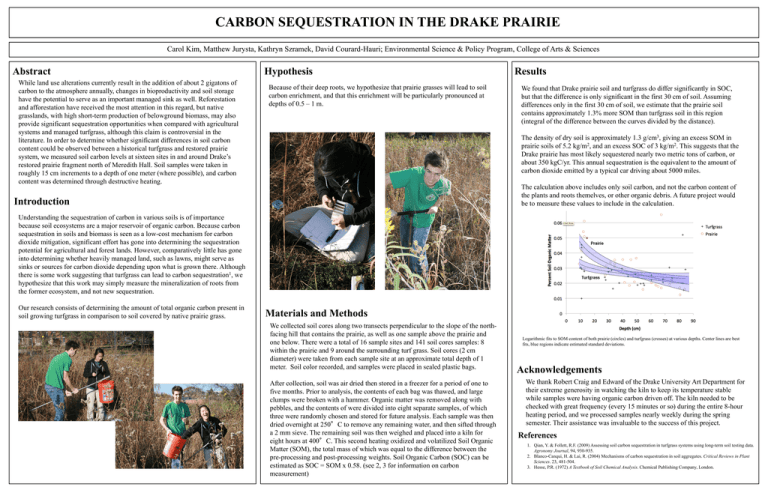Poster #32.pptx (3.696Mb)
advertisement

CARBON SEQUESTRATION IN THE DRAKE PRAIRIE Carol Kim, Matthew Jurysta, Kathryn Szramek, David Courard-Hauri; Environmental Science & Policy Program, College of Arts & Sciences Abstract While land use alterations currently result in the addition of about 2 gigatons of carbon to the atmosphere annually, changes in bioproductivity and soil storage have the potential to serve as an important managed sink as well. Reforestation and afforestation have received the most attention in this regard, but native grasslands, with high short-term production of belowground biomass, may also provide significant sequestration opportunities when compared with agricultural systems and managed turfgrass, although this claim is controversial in the literature. In order to determine whether significant differences in soil carbon content could be observed between a historical turfgrass and restored prairie system, we measured soil carbon levels at sixteen sites in and around Drake’s restored prairie fragment north of Meredith Hall. Soil samples were taken in roughly 15 cm increments to a depth of one meter (where possible), and carbon content was determined through destructive heating. Hypothesis Because of their deep roots, we hypothesize that prairie grasses will lead to soil carbon enrichment, and that this enrichment will be particularly pronounced at depths of 0.5 – 1 m. Results We found that Drake prairie soil and turfgrass do differ significantly in SOC, but that the difference is only significant in the first 30 cm of soil. Assuming differences only in the first 30 cm of soil, we estimate that the prairie soil contains approximately 1.3% more SOM than turfgrass soil in this region (integral of the difference between the curves divided by the distance). The density of dry soil is approximately 1.3 g/cm3, giving an excess SOM in prairie soils of 5.2 kg/m2, and an excess SOC of 3 kg/m2. This suggests that the Drake prairie has most likely sequestered nearly two metric tons of carbon, or about 350 kgC/yr. This annual sequestration is the equivalent to the amount of carbon dioxide emitted by a typical car driving about 5000 miles. The calculation above includes only soil carbon, and not the carbon content of the plants and roots themelves, or other organic debris. A future project would be to measure these values to include in the calculation. Introduction Understanding the sequestration of carbon in various soils is of importance because soil ecosystems are a major reservoir of organic carbon. Because carbon sequestration in soils and biomass is seen as a low-cost mechanism for carbon dioxide mitigation, significant effort has gone into determining the sequestration potential for agricultural and forest lands. However, comparatively little has gone into determining whether heavily managed land, such as lawns, might serve as sinks or sources for carbon dioxide depending upon what is grown there. Although there is some work suggesting that turfgrass can lead to carbon sequestration1, we hypothesize that this work may simply measure the mineralization of roots from the former ecosystem, and not new sequestration. Our research consists of determining the amount of total organic carbon present in soil growing turfgrass in comparison to soil covered by native prairie grass. Materials and Methods We collected soil cores along two transects perpendicular to the slope of the northfacing hill that contains the prairie, as well as one sample above the prairie and one below. There were a total of 16 sample sites and 141 soil cores samples: 8 within the prairie and 9 around the surrounding turf grass. Soil cores (2 cm diameter) were taken from each sample site at an approximate total depth of 1 meter. Soil color recorded, and samples were placed in sealed plastic bags. After collection, soil was air dried then stored in a freezer for a period of one to five months. Prior to analysis, the contents of each bag was thawed, and large clumps were broken with a hammer. Organic matter was removed along with pebbles, and the contents of were divided into eight separate samples, of which three were randomly chosen and stored for future analysis. Each sample was then dried overnight at 250°C to remove any remaining water, and then sifted through a 2 mm sieve. The remaining soil was then weighed and placed into a kiln for eight hours at 400°C. This second heating oxidized and volatilized Soil Organic Matter (SOM), the total mass of which was equal to the difference between the pre-processing and post-processing weights. Soil Organic Carbon (SOC) can be estimated as SOC = SOM x 0.58. (see 2, 3 for information on carbon measurement) Logarithmic fits to SOM content of both prairie (circles) and turfgrass (crosses) at various depths. Center lines are best fits, blue regions indicate estimated standard deviations. Acknowledgements We thank Robert Craig and Edward of the Drake University Art Department for their extreme generosity in watching the kiln to keep its temperature stable while samples were having organic carbon driven off. The kiln needed to be checked with great frequency (every 15 minutes or so) during the entire 8-hour heating period, and we processed samples nearly weekly during the spring semester. Their assistance was invaluable to the success of this project. References 1. Qian, Y. & Follett, R.F. (2009) Assessing soil carbon sequestration in turfgrass systems using long-term soil testing data. Agronomy Journal, 94, 930-935. 2. Blanco-Canqui, H. & Lai, R. (2004) Mechanisms of carbon sequestration in soil aggregates. Critical Reviews in Plant Sciences. 23, 481-504. 3. Hesse, P.R. (1972) A Textbook of Soil Chemical Analysis. Chemical Publishing Company, London.


